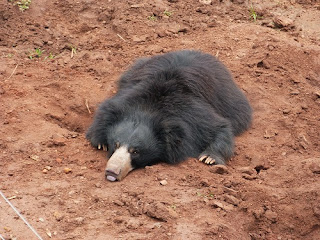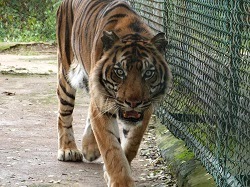So I helped to build an enrichment item! And then I watched the bears attempt to destroy it...
There's a constant cycle of rebuilding enrichment items (like platforms, frames to hang balls and logs from, etc) which are then destroyed within literally a few days or even a few hours. The workers feed the bears in the morning and the afternoon, provide some enrichment food mid-way, and the rest of the day is pretty much spent putting things back together for the bears to ecstatically demolish again.
 They are wily creatures...with the platform that I helped build, two of them worked together to dig out around the foundations before one of them climbed on top to give the whole structure a really good shake with its 130kg mass.
They are wily creatures...with the platform that I helped build, two of them worked together to dig out around the foundations before one of them climbed on top to give the whole structure a really good shake with its 130kg mass.I rediscovered my gecko room mate who had managed to hide from me very well: he took up residence in my sink. Literally, inside the sink...down the little hole at the back of the bowl that helps to prevent overflows. I discovered this when I returned from the centre slightly earlier than usual one day and, on opening the bathroom door, managed to give both of us a fright as I surprised him and in response he flip-flopped all around the sink bowl before scampering back into his home.
 The part of my study I enjoyed most was getting to sit and watch the bears...I've learnt so much about how they behave just through observing them and you can see their individual personalities. You get the chance to see some very funny behaviour too, like one bear who rugby tackled his dozing friend to instigate a mock fight or another playing in his water bowl on a particularly hot and sunny afternoon. It was great fun watching them with coconuts too, throwing them on the floor (they know to target concrete) in order to crack them open, before squabbling over the pieces. I've now received all of my data and am currently analysing it to see which food item was their favourite – from a first glance, coconut is the clear winner!
The part of my study I enjoyed most was getting to sit and watch the bears...I've learnt so much about how they behave just through observing them and you can see their individual personalities. You get the chance to see some very funny behaviour too, like one bear who rugby tackled his dozing friend to instigate a mock fight or another playing in his water bowl on a particularly hot and sunny afternoon. It was great fun watching them with coconuts too, throwing them on the floor (they know to target concrete) in order to crack them open, before squabbling over the pieces. I've now received all of my data and am currently analysing it to see which food item was their favourite – from a first glance, coconut is the clear winner!We had training in how to use GPS in order to track released animals - there's a female who will be released back into the wild soon, with a tracking collar to help provide more information about the lives of sloth bears in the wild, which will hopefully help reduce the number of human-bear conflicts that occur.
Unfortunately a trip to the hospital was also taken...I thought I was going to make it through without getting ill, but it wasn't to be. I had gastroenteritis for a few days, so although I was doing the typical British stiff upper lip ("honestly I'm fine, I don't need a doctor" while curled up in a ball on the floor) Dr Arun, rightly, made me take a trip to the hospital. I was given a supply of antibiotics and supplements to help me try and shift it.
My last few days were really good fun! I spent some time with one of the guys, Deepak, and his friends, going bowling and go karting, and then out to drinks at a roof top bar, watching the fireworks all over Bangalore city as processions took their Ganesha idols down to the lakes to submerge them.
I was also pretty surprised that the enrichment I made was still standing when I left – that’s British engineering for you!
On the last day, I also went on a safari around the national park (seeing elephants, lions, tigers, white tigers and, of course, the bears) and went to the zoo and the butterfly house. I said goodbye to the guys and thanked them for their hospitality - it was actually quite sad saying goodbye as this has certainly been a truly unforgettable experience.




